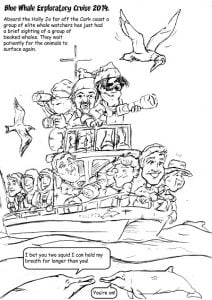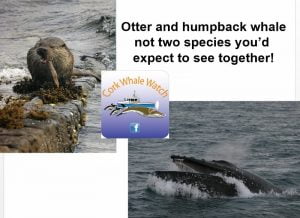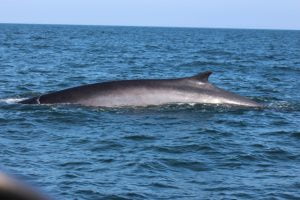
After a fantastic run of whale watching through July and August, with pod upon pod of fin whales, minke whales and common dolphins on show, things have been much quieter over the last few weeks. A combination of fresh easterly and south easterly winds, on top of high Atlantic swell, with very poor visibility in thick haze and fog have made it difficult to locate and watch any kind of cetaceans. The large gathering of fin whales seem to have dispersed, but there are still one or two pods around in the waters off West Cork, and as ever, plenty of common dolphins, and a few minke whales.
There is still a bloom of plankton in the surface layers and an awful lot of whitebait feeding on it and growing rapidly. Much of it is now large enough to be of interest for hungry whales to feed on, with huge numbers of oceanic birds picking a living from this abundance. There is, as yet, very little bait- ball activity, which triggers the whales into lunge feeding at the surface, under large aggregations of bird life. This action is most often directed at shoals of mature sprats, which seem to be almost non-existent after the continuing overfishing of them during their winter spawning season.
An interesting break in the daily routine of whale watching occurred at the start of September, when the Holly Jo went offshore, out to the Porcupine Seabight, in search of blue whales. For the past three years, there were sightings of blue whales, in company with large pods of fin whales in September. Nearly all of these sightings were in this area, observed from seismic survey vessels.
Perhaps we were too early in the month, and after a long search of the Seabight, where the abyssal Atlantic depths reach into the continental shelf, no fin or blue whales were seen. In one area there were dense shoals of bait fish, scattered over a mile or two, plenty enough of it to feed a good number of large whales, and these shoals had caught the attentions of a large number of common dolphins. In the same area we had a delightful encounter with a group of pilot whales, which stayed at the surface for a good while before disappearing into the depths. Just a few miles further to the north, we then had a brief encounter with a small pod of Sowerby’s beaked whales. Very little is known about the life and habits of these small whales, except that they are only observed off the continental shelf where the depth runs to a thousand metres or more. These animals dived almost as soon as they were seen. We stopped engines and waited for a while in the hope they might surface nearby and spend a bit of time refreshing their lungs, but there were no further signs of them. Even though conditions were near calm and clear air, our search effort was hampered by a long rolling swell of two to three metres. Without this swell, I felt we might have had more sightings of beaked whales, and there were very brief glimpses of unidentified animals of similar size now and again. The plan is to try again next year and maybe we’ll get lucky…..


